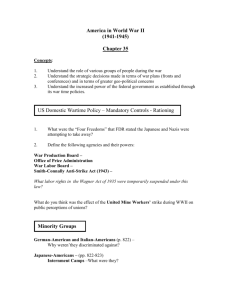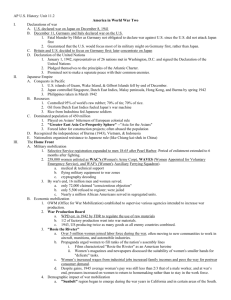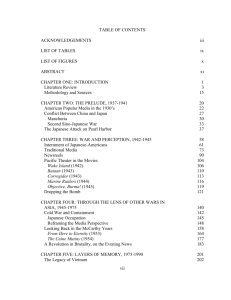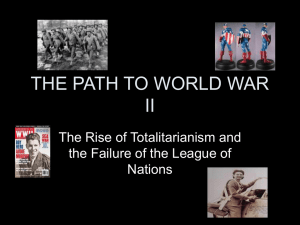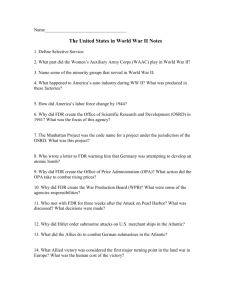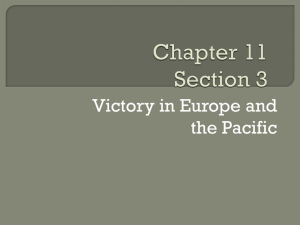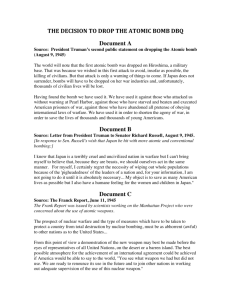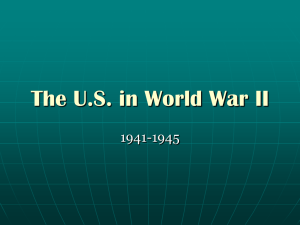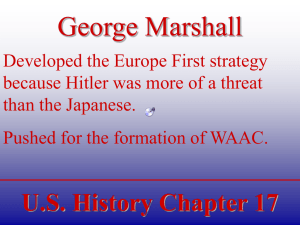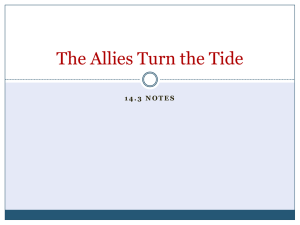THE UNITED STATES IN WORLD WAR II
advertisement
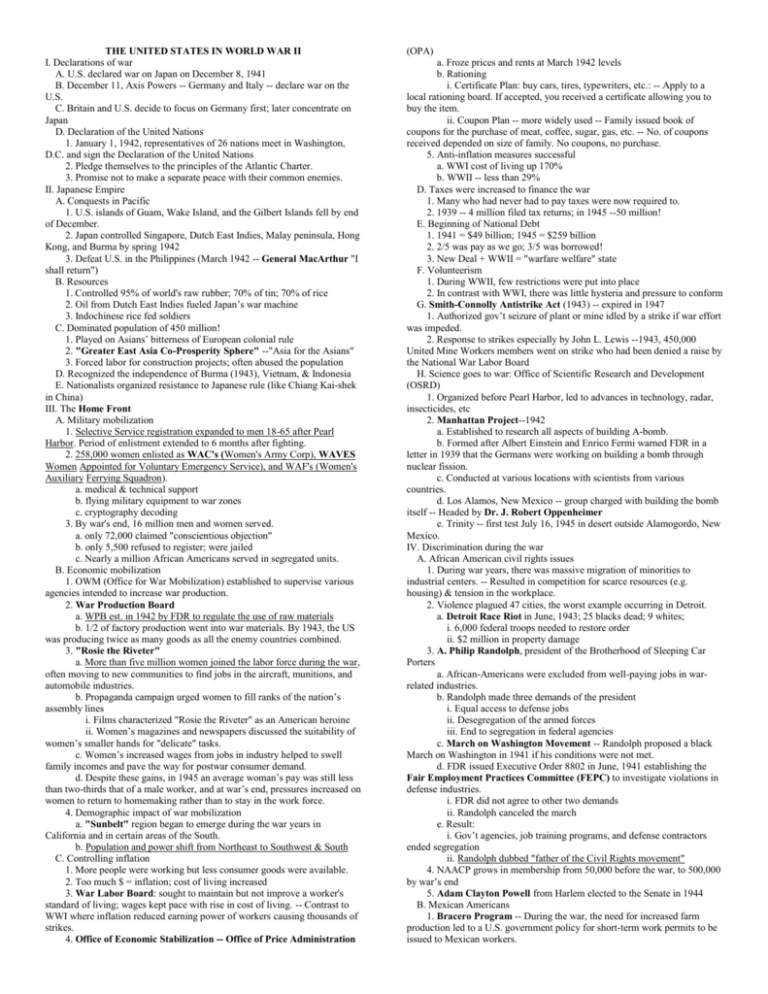
THE UNITED STATES IN WORLD WAR II I. Declarations of war A. U.S. declared war on Japan on December 8, 1941 B. December 11, Axis Powers -- Germany and Italy -- declare war on the U.S. C. Britain and U.S. decide to focus on Germany first; later concentrate on Japan D. Declaration of the United Nations 1. January 1, 1942, representatives of 26 nations meet in Washington, D.C. and sign the Declaration of the United Nations 2. Pledge themselves to the principles of the Atlantic Charter. 3. Promise not to make a separate peace with their common enemies. II. Japanese Empire A. Conquests in Pacific 1. U.S. islands of Guam, Wake Island, and the Gilbert Islands fell by end of December. 2. Japan controlled Singapore, Dutch East Indies, Malay peninsula, Hong Kong, and Burma by spring 1942 3. Defeat U.S. in the Philippines (March 1942 -- General MacArthur "I shall return") B. Resources 1. Controlled 95% of world's raw rubber; 70% of tin; 70% of rice 2. Oil from Dutch East Indies fueled Japan’s war machine 3. Indochinese rice fed soldiers C. Dominated population of 450 million! 1. Played on Asians’ bitterness of European colonial rule 2. "Greater East Asia Co-Prosperity Sphere" --"Asia for the Asians" 3. Forced labor for construction projects; often abused the population D. Recognized the independence of Burma (1943), Vietnam, & Indonesia E. Nationalists organized resistance to Japanese rule (like Chiang Kai-shek in China) III. The Home Front A. Military mobilization 1. Selective Service registration expanded to men 18-65 after Pearl Harbor. Period of enlistment extended to 6 months after fighting. 2. 258,000 women enlisted as WAC's (Women's Army Corp), WAVES Women Appointed for Voluntary Emergency Service), and WAF's (Women's Auxiliary Ferrying Squadron). a. medical & technical support b. flying military equipment to war zones c. cryptography decoding 3. By war's end, 16 million men and women served. a. only 72,000 claimed "conscientious objection" b. only 5,500 refused to register; were jailed c. Nearly a million African Americans served in segregated units. B. Economic mobilization 1. OWM (Office for War Mobilization) established to supervise various agencies intended to increase war production. 2. War Production Board a. WPB est. in 1942 by FDR to regulate the use of raw materials b. 1/2 of factory production went into war materials. By 1943, the US was producing twice as many goods as all the enemy countries combined. 3. "Rosie the Riveter" a. More than five million women joined the labor force during the war, often moving to new communities to find jobs in the aircraft, munitions, and automobile industries. b. Propaganda campaign urged women to fill ranks of the nation’s assembly lines i. Films characterized "Rosie the Riveter" as an American heroine ii. Women’s magazines and newspapers discussed the suitability of women’s smaller hands for "delicate" tasks. c. Women’s increased wages from jobs in industry helped to swell family incomes and pave the way for postwar consumer demand. d. Despite these gains, in 1945 an average woman’s pay was still less than two-thirds that of a male worker, and at war’s end, pressures increased on women to return to homemaking rather than to stay in the work force. 4. Demographic impact of war mobilization a. "Sunbelt" region began to emerge during the war years in California and in certain areas of the South. b. Population and power shift from Northeast to Southwest & South C. Controlling inflation 1. More people were working but less consumer goods were available. 2. Too much $ = inflation; cost of living increased 3. War Labor Board: sought to maintain but not improve a worker's standard of living; wages kept pace with rise in cost of living. -- Contrast to WWI where inflation reduced earning power of workers causing thousands of strikes. 4. Office of Economic Stabilization -- Office of Price Administration (OPA) a. Froze prices and rents at March 1942 levels b. Rationing i. Certificate Plan: buy cars, tires, typewriters, etc.: -- Apply to a local rationing board. If accepted, you received a certificate allowing you to buy the item. ii. Coupon Plan -- more widely used -- Family issued book of coupons for the purchase of meat, coffee, sugar, gas, etc. -- No. of coupons received depended on size of family. No coupons, no purchase. 5. Anti-inflation measures successful a. WWI cost of living up 170% b. WWII -- less than 29% D. Taxes were increased to finance the war 1. Many who had never had to pay taxes were now required to. 2. 1939 -- 4 million filed tax returns; in 1945 --50 million! E. Beginning of National Debt 1. 1941 = $49 billion; 1945 = $259 billion 2. 2/5 was pay as we go; 3/5 was borrowed! 3. New Deal + WWII = "warfare welfare" state F. Volunteerism 1. During WWII, few restrictions were put into place 2. In contrast with WWI, there was little hysteria and pressure to conform G. Smith-Connolly Antistrike Act (1943) -- expired in 1947 1. Authorized gov’t seizure of plant or mine idled by a strike if war effort was impeded. 2. Response to strikes especially by John L. Lewis --1943, 450,000 United Mine Workers members went on strike who had been denied a raise by the National War Labor Board H. Science goes to war: Office of Scientific Research and Development (OSRD) 1. Organized before Pearl Harbor, led to advances in technology, radar, insecticides, etc 2. Manhattan Project--1942 a. Established to research all aspects of building A-bomb. b. Formed after Albert Einstein and Enrico Fermi warned FDR in a letter in 1939 that the Germans were working on building a bomb through nuclear fission. c. Conducted at various locations with scientists from various countries. d. Los Alamos, New Mexico -- group charged with building the bomb itself -- Headed by Dr. J. Robert Oppenheimer e. Trinity -- first test July 16, 1945 in desert outside Alamogordo, New Mexico. IV. Discrimination during the war A. African American civil rights issues 1. During war years, there was massive migration of minorities to industrial centers. -- Resulted in competition for scarce resources (e.g. housing) & tension in the workplace. 2. Violence plagued 47 cities, the worst example occurring in Detroit. a. Detroit Race Riot in June, 1943; 25 blacks dead; 9 whites; i. 6,000 federal troops needed to restore order ii. $2 million in property damage 3. A. Philip Randolph, president of the Brotherhood of Sleeping Car Porters a. African-Americans were excluded from well-paying jobs in warrelated industries. b. Randolph made three demands of the president i. Equal access to defense jobs ii. Desegregation of the armed forces iii. End to segregation in federal agencies c. March on Washington Movement -- Randolph proposed a black March on Washington in 1941 if his conditions were not met. d. FDR issued Executive Order 8802 in June, 1941 establishing the Fair Employment Practices Committee (FEPC) to investigate violations in defense industries. i. FDR did not agree to other two demands ii. Randolph canceled the march e. Result: i. Gov’t agencies, job training programs, and defense contractors ended segregation ii. Randolph dubbed "father of the Civil Rights movement" 4. NAACP grows in membership from 50,000 before the war, to 500,000 by war’s end 5. Adam Clayton Powell from Harlem elected to the Senate in 1944 B. Mexican Americans 1. Bracero Program -- During the war, the need for increased farm production led to a U.S. government policy for short-term work permits to be issued to Mexican workers. 2. Zoot Suit riots in L.A. (1943) a. Young Mexican-Americans became object of frequent violent attacks in LA. b. Sailors on leave roamed streets beating "zooters," tearing their clothes, cutting their hair. c. Radio reports blamed zooters but a city committee under Earl Warren revealed the truth and need for improved housing. C. Internment of Japanese Americans -- Japanese relocation 1. Executive Order 9066 (Feb. 19, 1942) -- FDR authorized the War Dept. to declare the West Coast a "war theater". 2. 110,000 people of Japanese ancestry were forcibly interned. Pearl Harbor left public paranoid that people of Japanese ancestry living in California might help Japan. a. 1/3 were Issei -- foreign born b. rest were Nisei -- American born usually too young to vote 3. General John DeWitt organized the removal of people of Japanese ancestry to 10 locations in 7 states a. They were given 48 hours to dispose of their belongings -- Most families received only about 5% of their possessions’ worth. b. Camps were in desolate areas c. Conditions harsh, yet many remained loyal to US; after 1943, 17,600 Nisei fought in US Army. d. Relocation became "necessary" when other states would not accept Japanese residents from California. e. Although gov’t considered relocation of Germans and Italians, the Japanese were the only ethnic group singled out by the gov’t for action. 4. Army considered Japanese potential spies. a. Korematsu v. US – Supreme Court upholds internment i. Could not second-guess military decisions ii. Court also ruled that persons couldn’t be held once loyalty was established. -- By then, camps were being closed down. b. Seen by military as potential "fifth column" 5. Labor and business wanted Japanese removed to help themselves 6. Represented the greatest violation of civil liberties during WWII a. $105 million of farmland lost b. $500 million in yearly income; unknown personal savings. 7. No act of sabotage was ever proven against any Japanese-American 8. Camps closed in March, 1946 9. 1988, President Reagan officially apologized for its actions and approved in principle the payment of reparations to camp survivors totaling $1.25 billion. 10. In 1990 Congress appropriated funds to pay $20,000 to each internee. Background: 1942 was a critical year for the survival of the Allied powers. Japan controlled all of Southeast Asia and most of China; Germany controlled Western Europe, N. Africa, and were deep inside the Soviet Union. V. The Grand Alliance A. A coalition of the nations who were at war with the Axis Powers created with the signing of the "United Nations Declaration", Jan 1, 1942. -- FDR & Churchill's close relationship helped B. Objectives 1. Hitler first -- Churchill & FDR wanted to concentrate on defeating Germany before giving Japan higher priority. 2. Many who were outraged from Pearl Harbor complained. C. Military Plans: 1. Economic blockades on Germany & Italy 2. Air attacks on Germany 3. Peripheral strikes in the Mediterranean 4. Final direct assault on Germany VI. Allied defeats: during first 6 months, it looked likely that the Allied Powers would lose the war. A. Asia and the Pacific 1. Japanese took Guam, Wake Island, Hong Kong, Singapore, Burma, Dutch East Indies, and the Philippines. -- Important Burma Road supply route into China from India was cut. 2. U.S. loss of the Philippines a. 20,000 U.S. troops led by General Douglas MacArthur withdrew to Bataan, close to Manila, but eventually surrendered. b. Bataan death march – 85-mile forced march of U.S. GIs who were tortured and eventually burned alive. c. MacArthur ordered by Washington to leave secretly for Australia. i. "I shall return" ii. Assumes command of all Allied Pacific forces 3. Doolittle Raid: Americans executed a militarily insignificant raid on Japan in April, 1942 in retaliation for Pearl Harbor. -- Helped American moral since U.S. had not yet struck back after Pearl Harbor. B. Early Defeats in Europe 1. German submarines sunk 8 million tons worth of allied supplies -- 25% of the USSR's. 2. Germans were as Far East as Stalingrad by fall 1942, and as deep as El Alamein, Egypt VII. Allied Turning Points in the War A. Battle of Stalingrad (Sept. 1942) 1. Perhaps most important battle of the war a. First major Nazi defeat on land b. Henceforth, German army in retreat from the east until Berlin is occupied by the Russians in the spring of 1945. 2. Stalin never forgave the Allies for not opening a 2nd front earlier; USSR had to bear the full brunt of Nazi invasion. -- Churchill opted for North Africa instead. B. North Africa -- Operation "Torch" - led by Gen. Eisenhower, Nov. 8, 1943 1. British had been desperately fighting German Panzer divisions in North Africa since 1941. -- Germans led by General Irwin Rommel (the "Desert Fox") 2. Nov. 1943, 100,000 Allied troops invaded N. Africa in Algeria & Morocco (Casablanca) 3. Major victory at the Battle of El Alamein—signaled end of Nazi presence in N. Africa -- Pushed Rommel all the way to Tunisia; massive German casualties. C. Europe 1. Invasion of Italy (commanded by George C. Patton) a. July 10, 1943, British and U.S. forces land on Sicily; victorious within 1 month b. Mussolini forced out of power by officials within fascist party. c. June 4, 1944 -- Allies march into Rome -- First capital city freed from Nazi control d. Other parts of Italy remain under Nazi control until Spring 1945. 2. D-Day (June 6, 1944) -- “Operation Overlord” – perhaps wars most important battle a. Commanded by General Dwight D. Eisenhower b. 120,000 troops left England and landed at 5 beachheads at Normandy Coast. i. 800,000 more men within 3 weeks; 3 million total ii. Demonstrated significance of Battle of Britain four years earlier c. Casualties during D-Day: 2,245 Allies killed; 1,670 wounded d. Significance of battle: i. Second front established (to Russia’s joy) -- August 25, 1st Allied troops enter Paris. -- By end of summer, Belgium, France and Luxembourg liberated ii. Had Allies failed, Hitler could have focused on Eastern Front and perhaps negotiated an end to the war with Stalin leaving most of Europe under Nazi control. 3. Invasion of Germany a. Pre-invasion bombing i. Hamburg all but wiped out in summer 1943 ii. Berlin and other major cities and targets hit repeatedly especially factories and oil refineries. b. Allied invasion in Sept. 1944 repelled by Germany -- Had arrived at the Rhine by mid-September on the edge of Germany. c. Battle of the Bulge (December 16, 1944) i. Germans launched last major offensive on U.S. positions in Belgium and Luxembourg -- U.S. casualties: nearly 80,000 ii. General George Patton and his 101st Airborne Division stopped Hitler’s last gasp counter-offensive iii. By January, the Allies were once more advancing toward Germany. d. Britain & US attack Dresden with fire bombs killing 100,000 & destroying factories & rail lines. e. April 1945 i. U.S. approach Berlin from west while Soviets come from east. ii. German resistance in Italy collapsing. iii. Mussolini caught by Italian resistance and killed f. Hitler goes into bunker under Chancellery in April and commits suicide on April 30. g. Germany surrenders unconditionally on May 7, 1945 -- Allies celebrate V-E Day (Victory in Europe Day) D. Japan is pushed back to its mainland 1. Battle of the Coral Sea (May 1942) – entire battle fought with aircraft. -- Japan prevented from successfully invading New Guinea and Australia. 2. Battle of Midway (June 4-7, 1942) – turning point in the Pacific war a. Allies broke the Japanese code. b. Japan lost 4 aircraft carriers (of 10)--7 of 11 other ships destroyed; 250 planes. c. Significance: Japan no longer had any hopes of attacking US mainland. -- Yet, Japanese- Americans still interned 3. Island Hopping campaign begins in 1943 – eventually pushed Japanese forces all the way back to Japan. a. Sought to neutralize Japanese island strongholds with air and sea power and then move on. b. Battle of Guadalcanal (Solomon Islands -- August 1942-February 1943) -- First Japanese land defeat after 6 months of bitter jungle fighting. 4. Iwo Jima (February, 1945) -- Fighter planes now close enough to bomb Japan (would escort B-29s coming from the Marianas) 5. Okinawa (April 1, 1945 -- ends in June) a. 50,000 American casualties resulted from fierce fighting which virtually destroyed Japan’s remaining defenses. b. Bloodshed influenced the eventual use of the atomic bomb to prevent further U.S. casualties from ground assaults. 6. Bombing of Japan results in destruction of most major cities -- March 1945, 100,000 die in a single Tokyo raid; 60% of buildings destroyed. VIII. Election of 1944 and death of FDR A. FDR, with running-mate Harry S. Truman, defeated Republican opponent Thomas Dewey. -- FDR elected to an unprecedented fourth term in office. B. April 12, 1945 -- FDR dies at Warm Springs, GA C. Harry Truman becomes president IX. The Atomic Bomb A. U.S. successfully tests bomb in mid-July, 1945 at Alamagordo, New Mexico. B. Potsdam Conference (Mid-July - August) 1. Three allied leaders (Truman, Stalin, and Clement Atlee) warn Japan w/o specifics to surrender or suffer "complete and utter destruction." 2. Japan refuses removal of emperor but shows signs in secret dispatches it might be willing to surrender if emperor remains on throne. 3. Military advisors warn of casualties as high as 46,000 if U.S. invades Japan. C. August 6, 1945 -- First atomic bomb dropped on Hiroshima 1. 80,000 killed immediately; 100,000 injured -- Countless die later of radiation sickness or cancer 2. Bomb dropped by the Enola Gay 3. Japanese gov’t still does not surrender D. August 8, Soviet Union enters the war against Japan as promised E. August 9 -- 2nd bomb dropped on Nagasaki; 60,000 dead F. August 14 -- Japan surrenders 1. World War II is over. 2. September 2, Japanese formally surrender aboard U.S.S. Missouri in Tokyo Bay. G. The decision to drop the atomic bomb became controversial in past few decades. 1. Recent scholarship suggests Truman sought to intimidate Soviet Union in the post-war world by using the bomb. Proponents of Truman’s decision say that this was not a key issue in Truman’s decision making; ending the war was the overriding goal 2. Some suggest a demonstration of the bomb to Japan was a viable alternative. Yet, U.S. did not know if the bomb would work and only two bombs available in August 1945. 3. Proponents of the bomb’s use argue that bloody U.S. victories at Iwo Jima and Okinawa were only a preview of the horrific carnage that would occur if U.S. invaded the mainland. Japan was preparing women and children to defend Japan as well. 4. Some military officials believed Japan could be broken by the naval blockade and continued conventional bombing. General Eisenhower later lamented use of the bomb. 5. Critics of the decision maintain the U.S. let the emperor on the throne after the war: why not make that clear before using the bomb? 6. Some critics argue that Hiroshima was not a crucial military target and that civilians instead were the target. Hiroshima and Nagasaki had been spared bombing up until then. 7. Some critics argue that even if Hiroshima bombing was somewhat justified, the quick bombing of Nagasaki three days later was not. 8. Some critics argue that Truman and others connected with the gov’t mislead the public about the use of the bomb by misinformation in the press and movies. X. Allied Diplomacy during the war A. Casablanca Conference (January 14-25, 1943) 1. FDR and Winston Churchill declare a policy of unconditional surrender for "all enemies" 2. Agreed that Italy would be invaded first before opening a 2nd Front in France. B. Moscow Conference (October 1943) -- Secretary of State Cordell Hull obtained Soviet agreement to enter the war against Japan after Germany was defeated and to participate in a world organization after the war was over. C. Declaration of Cairo (issued December 1, 1943) 1. FDR met with Chang Kai-shek in November calling for Japan’s unconditional surrender. 2. Stated that all Chinese territories occupied by Japan would be returned to China and that Korea would be free and independent. D. Tehran Conference (November 28-December 1, 1943) 1. First meeting of the "Big Three" -- FDR, Stalin, and Churchill 2. Allies agree to an invasion of the Western Europe in 1944. 3. Stalin reaffirmed the Soviet commitment to enter the war against Japan and discussed coordination of the Soviet offensive with the Allied invasion of France. 4. Disputes over post-war world a. Stalin insisted on Soviet control of Eastern Europe and the carving up of Germany b. Churchill demanded free governments in Eastern Europe and a strong Germany after the war to preserve a balance of power in Europe. c. Roosevelt acted as a mediator and believed he could work with Stalin to achieve a post-world peace within the construct of the United Nations. E. Yalta Conference (February 4-11, 1945) 1. "Big Three" met to discuss post-war Europe. 2. Stalin agreed to enter Pacific war within 3 months after Germany surrendered 3. Stalin agreed to a "Declaration of Liberated Europe" which called for free elections. 4. Called for a world organization to meet in the U.S. beginning on April 25, 1945 and agreed Soviets would have 3 votes in the General Assembly and that the U.S., Great Britain, the Soviet Union, France and China would be permanent members of the Security Council. 5. Germany divided into occupied zones and a coalition government of communists and non-communists was agreed to for Poland. -- U.S.S.R. allowed to keep its pre-1939 territory. 6. FDR accepted Soviet control of Outer Mongolia, the Kurile Islands, the southern half of Sakhalin Island, Port Arthur (Darien), and participation in the operation of the Manchurian railroads. F. Potsdam Conference (July 17 to August 2, 1945) 1. Truman, Stalin, and Clement Atlee (Britain) met at Potsdam, eastern Germany. 2. Conference disagreed on most issues; war alliance beginning to break down. 3. During conference, Truman ordered dropping of the atomic bomb on Japan. 4. Established a Council of Foreign Ministers to draft peace treaties for the Balkans. 5. Approvals given to concept of war-crimes trials and the demilitarization and denazification of Germany. -- Reparations from Germany could be taken from each respective zone. XI. Aftermath A. Massive casualties 1. 46-55 million dead; 35 million wounded; 3 million missing a. About 30 million soldiers died (including about 300,000 Americans) b. 25 million civilians -- 15 million in USSR alone (23 million combined with military casualties)! B. 30 million Europeans lost their homeland (60% of them German) and relocated C. Massive destruction of cities (4 million homes in Britain; 7 million buildings in Germany; 1,700 towns destroyed in USSR) D. Holocaust 1. Six million Jews were liquidated as part of Hitler's "Final Solution" 2. Six million others also killed including Gypsies, Homosexuals, physically handicapped, Jehovah’s Witnesses and political opponents. 3. U.S. response to Europe’s Jews before and during the war was extremely biased. a. "Americanism" of 1920s continued into 1940s with strong antiSemitism b. 40% of German immigration quota between 1933 & 1945 was unfilled while German Jews tried to get into the U.S. c. At one point, U.S. forced a ship full of German Jews that had made it to U.S. shores to turn around and go back to Germany. Many did in Nazi camps. XII. Post-war Political issues A. WWII made allies of ideological enemies 1. Prior to WWII, Stalin's communist dictatorship was condemned by the West. 2. Soviets conversely denounced "Western Imperialism" 3. Once the war was over, the rivalry between East & West quickly reemerged B. Fate of Eastern Europe 1. By war's end, the Soviets controlled most of Eastern Europe. a. Bulgaria, Romania, and Hungary surrendered to Soviets when they were invaded. b. Soviets drive Nazis from Poland and Czech. 2. Stalin promises free elections; West is wary that Europe will have communist governments imposed. C. Germany's fate 1. Soviets wished for a weak Germany 2. Britain & US wanted a strong economic Germany and a healthy democracy. D. Shift in balance of power 1. Western Europe was no longer the leader in world affairs. 2. US & USSR emerged as the two superpowers XIV. The Postwar World A. Nationalism becomes a major force throughout the world. 1. Colonies ruled by European nations demanded independence. 2. India had been promised greater freedom as a reward for fighting in the war. 3. French Indochina determined to resist European rule; nationalists had fought against Japanese. B. Social changes 1. African-Americans gained job opportunities during the war that had long been denied. -- Hopes were raised that further action against racial discrimination was raised. 2. Many women saw a future of wider opportunity after the war, while many returned to the home. 3. Shift in population to the "sunbelt" C. Technology 1. Synthetic materials such as plastics were developed to replace natural ones in short supply. 2. Improvement in airplanes and radar changed war 3. A-bomb changed the course of human history; years after 1945 called "Atomic Age" D. End of WWII sowed the seeds for the onset of the Cold War: 1946-1992
